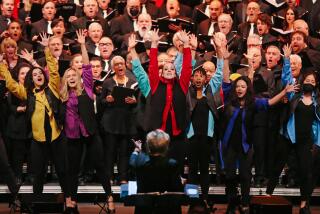HANDBELL CHOIRS TO RING OUT
- Share via
There’s an adage that takes on special significance for ringers in handbell choirs: He who hesitates is lost.
“If you don’t ring your bell at the right time, it’s not going to be rung because no one else has that bell,” said Richard Knox, director of the Geneva Carillon Handbell Choir in Laguna Hills.
“There’s no such thing as a person that’s not very important in a handbell choir,” added Bud Bisbee, director of the Christ College Irvine advanced handbell choir.
The Geneva choir will perform Saturday) and Sunday at 7 p.m. in holiday concerts with the Saddleback Concert Chorale at the Mission Viejo college campus. The Christ College group will perform in a Christmas concert Monday at 8 p.m. at Zion Lutheran Church in Anaheim.
While these are two of the more prominent Orange County handbell choirs, Knox estimated that there may be several hundred handbell groups in the county. Local churches often have handbell choirs and may be planning holiday concerts. The ability to play the right note at the right time isn’t the only requirement for the 8 to 12 ringers in a typical choir. The way they play the note is important too.
“Anyone can make a noise on a bell, but the process of acquiring the capacity to ring loudly, to ring softly, to start the tone and stop the tone--these obviously are things that take a bit of time,” Knox said. “But they’re not overwhelmingly difficult.”
According to Knox, ringers of the large cast church bells in England developed chromatic handbells for practicing. Eventually, the English began using the small bells to ring out simple tunes.
Handbells were introduced in the United States in the last century and have gained in popularity. An amateur handbell ringers competition was held in Boston in 1895. Knox estimated that there are about 7,000 handbell choir directors in the American Guild of English Handbell Ringers, and many of these directors lead several choirs. And, Knox added, there are probably many handbell choir directors who do not belong to the guild.
“It’s been a wonderful expansion--or explosion, actually--of interest,” said Knox, a former member of the guild’s national board. “The handbell choirs in this country have eclipsed the handbell experience in the parent country. In England, they are still ringing little tunes . . . whereas in this country, you have a more symphonic quality. Handbells are conceived of as an orchestra.”
The endeavor for a symphonic effect places special demands on handbell choir members, Bisbee said. “I’ve always treated handbells just like a regular musical instrument, asking the same thing out of them: shaping, dynamic variety,” he said. “It’s harder for the ringers to do it because they never play a whole musical line. All they play is two notes in that line.”
With each member of a choir assigned as many as four bells, the bell-changing techniques can be quite intricate, adding to their audience appeal, Bisbee said. “Handbells are very well received because they’re so visual.”
Knox, a retired music professor, was faced with a special problem when he took over the bell choir at Geneva Presbyterian Church. Handbells can weigh up to 10 pounds each, and many members of the church--which is located just outside the border of Leisure World--are senior citizens. So Knox developed a console that holds the 13 heaviest bells and can be operated by a single person--in this case Knox’s wife Cleo. The console idea has since been adopted by several other choirs across the country.
Most handbell choirs are associated with churches, Knox said, and are especially popular during the holiday season. “It’s a very rich, exciting experience, and everyone naturally likes to hear them around Christmas,” said Knox, a handbell enthusiast since the ‘60s. “But they obviously can ring anytime of the year.”
More to Read
The biggest entertainment stories
Get our big stories about Hollywood, film, television, music, arts, culture and more right in your inbox as soon as they publish.
You may occasionally receive promotional content from the Los Angeles Times.










